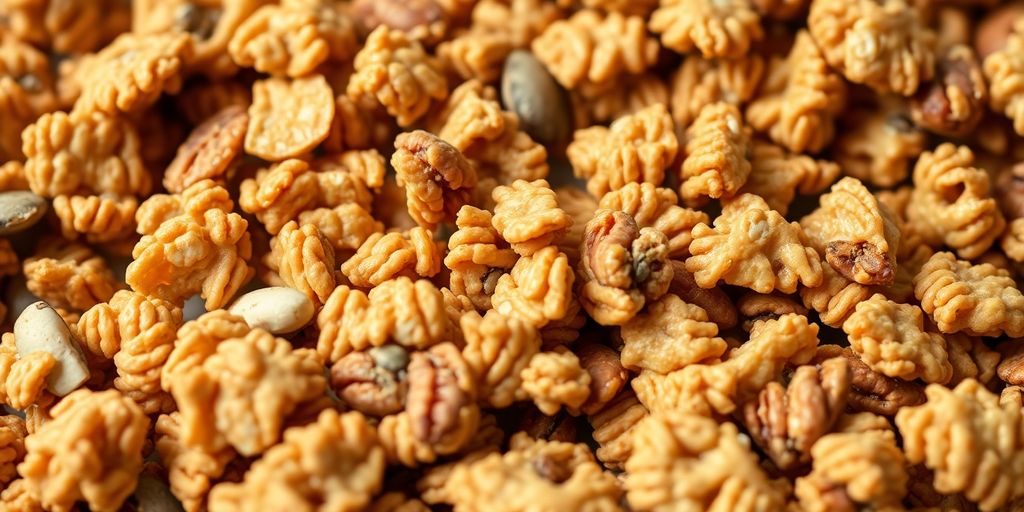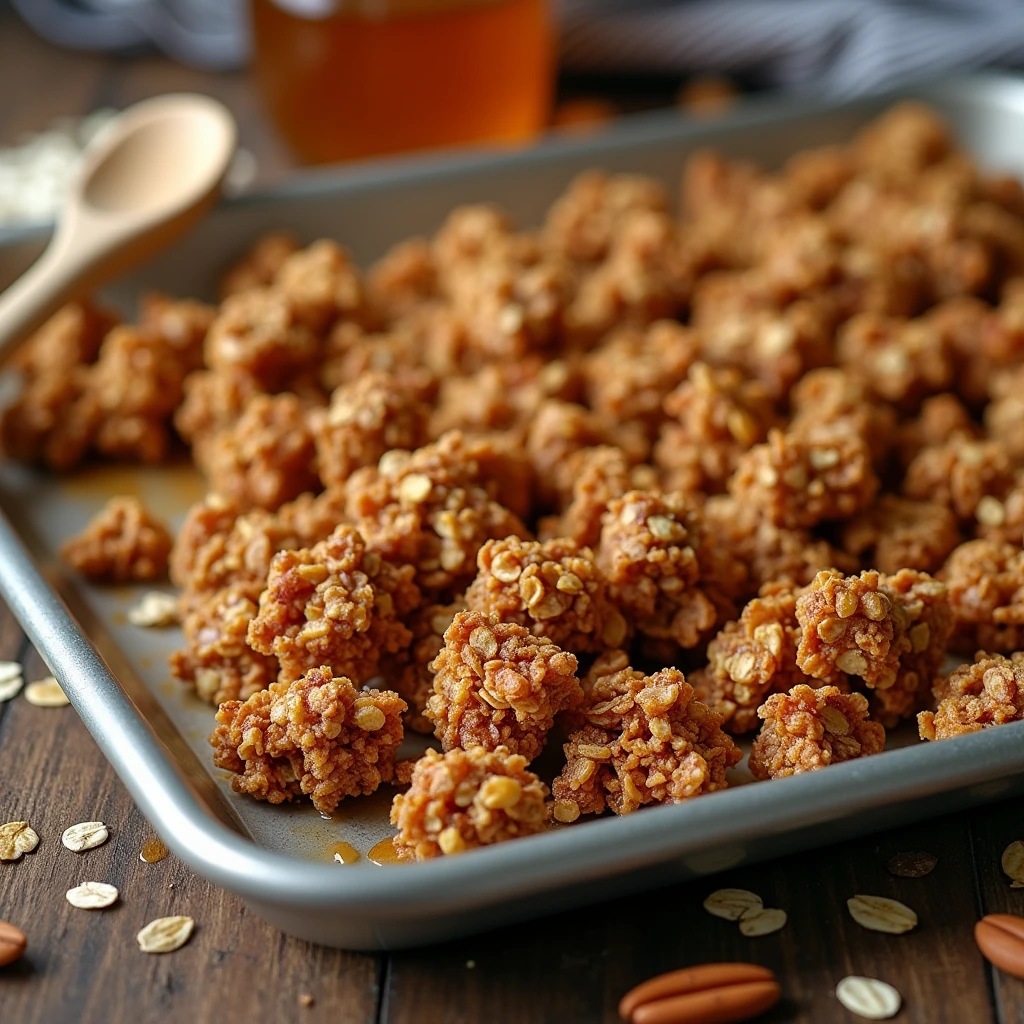Ever wondered what makes granola stick together and stay crunchy? It’s not just about throwing oats and nuts together. There’s a bit of science and a few secret ingredients involved. From binders to sweeteners and baking techniques, each element plays a role in achieving that perfect crunchy texture. Let’s dive into the world of granola and uncover the secrets behind those delightful clusters.
Key Takeaways
- Egg whites work as a natural binder, helping granola stick together.
- Sweeteners like honey and maple syrup not only add flavor but also affect the crunchiness.
- Proper baking techniques, including temperature and stirring, are crucial for cluster formation.
- Innovative ingredients like bran flakes and oat flour can enhance texture and binding.
- Avoid common mistakes like overmixing or incorrect baking times to maintain the perfect crunch.
Understanding the Role of Binders in Granola
Egg Whites as a Natural Glue
Egg whites are like nature’s adhesive for granola. When you beat them until they’re foamy, they become the perfect binder, holding all those oats and nuts together. This simple ingredient ensures your granola forms those satisfying clusters. To get the best results, whip your egg whites until they increase in volume and gently fold them into your granola mix.
The Function of Bran Flakes and Wheat Germ
Bran flakes and wheat germ might not be the first ingredients you think of for granola, but they play a unique role. Bran flakes act like little rafts, providing a base for the other ingredients to cling to, while wheat germ mixes with sweeteners to form a delicious mortar. Together, they help create those coveted clusters that make granola so snackable.
Using Oat Flour for Clumpier Granola
If you’re looking for a way to make your granola clumpier without adding extra ingredients, oat flour is your friend. Just grind some of your oats into a fine flour and mix it with the rest of your dry ingredients. The oat flour works its magic by coating everything, helping the granola stick together during baking. This method gives you small, crispy clusters without needing to add more fat or liquid.
Exploring Sweeteners and Their Impact on Granola Texture
Honey vs. Maple Syrup
When it comes to sweetening your granola, the choice between honey and maple syrup can significantly affect the final texture. Honey tends to be thicker and stickier, which can help bind the oats and other ingredients together, resulting in larger clusters. On the other hand, maple syrup is more fluid and can create a more evenly distributed sweetness throughout the granola. However, both honey and maple syrup have a higher tendency to burn in the oven compared to plain sugar. This can lead to a darker, sometimes bitter taste if not monitored closely.
The Role of Sugar in Granola
Sugar might not sound as exciting as its natural counterparts, but it has a unique role in granola making. When heated, sugar melts and spreads, coating the ingredients, and upon cooling, it solidifies to create a crisp and crunchy texture. This process can be crucial for achieving that perfect crunch in your granola. Unlike honey or maple syrup, sugar can withstand prolonged heat without burning, making it a reliable choice for those seeking a less sweet, more caramelized flavor.
How Sweeteners Affect Crunchiness
The type of sweetener used in granola not only influences taste but also impacts crunchiness. Sugars, when heated, undergo a process that aligns their molecules, resulting in a crisp and crunchy texture. This is why granola sweetened with sugar often has a more pronounced crunch compared to those made with honey or maple syrup. Additionally, the amount of sweetener used can determine how well the granola clumps together. A higher concentration of sweetener typically results in larger clusters, while less sweetener might lead to a looser mix.
The Art of Baking Granola for Maximum Crunch

The Importance of Baking Temperature
Getting the right crunch in granola is all about the baking temperature. Too hot, and you risk burning; too low, and you’ll end up with a chewy mess. Aim for a moderate oven temperature, around 300°F (150°C). This allows the ingredients to toast evenly, bringing out the nutty flavors while keeping the texture just right.
Stirring Techniques for Cluster Formation
Creating those perfect clusters often comes down to how you stir your granola. Start by mixing your ingredients thoroughly before baking. Once in the oven, stir the granola halfway through the baking time to ensure even cooking. Stop stirring towards the end to let clusters form naturally as the sugars caramelize.
Cooling Methods to Preserve Crunch
Once your granola is out of the oven, let it cool completely on the baking sheet. This step is crucial. Allowing it to cool undisturbed helps the clusters set, maintaining their shape and crunch. Once cooled, store it in an airtight container to keep it fresh and crunchy for weeks.
Innovative Ingredients for Crunchy Granola
Incorporating Nuts and Seeds
Adding nuts and seeds to granola not only enhances its nutritional value but also contributes to its crunch. Almonds, walnuts, and pecans are popular choices. They bring a satisfying texture and rich flavor. Seeds like pumpkin, sunflower, and chia add a unique crunch and are packed with nutrients. You can toast these ingredients beforehand to intensify their flavors and ensure they stay crunchy.
The Use of Dried Fruits
Dried fruits can be a delightful addition to granola, offering sweetness and chewiness. However, they should be added after baking to prevent them from becoming too hard or burnt. Raisins, cranberries, and apricots are common choices. They provide a natural sweetness that complements the oats and nuts. Remember, a little goes a long way, so balance is key.
Adding Spices for Extra Flavor
Spices can elevate the flavor profile of your granola without adding extra calories. Cinnamon, nutmeg, and ginger are popular options. They add warmth and depth, making each bite more enjoyable. You can experiment with different spice combinations to find the perfect blend that suits your taste. A sprinkle of salt can also enhance the overall flavor, balancing the sweetness of the other ingredients.
Techniques for Achieving Perfect Granola Clusters

The Sandwiching Method with Sheet Pans
Creating those delightful granola clusters can be as simple as using the sandwiching method. This technique involves spreading your granola mixture evenly on a baking sheet, then placing another sheet on top. This setup helps in compressing the mixture, encouraging the formation of larger clusters. The result? Granola that’s both crunchy and full of those big, satisfying clusters.
Using Buttermilk for Tender Clusters
Buttermilk isn’t just for pancakes; it can be a game changer for your granola too. The acidity in buttermilk helps tenderize the oats, allowing them to clump together more effectively. Simply mix a bit of buttermilk into your granola blend before baking. You’ll find this adds a subtle tangy flavor and makes the clusters more tender.
The Impact of Fat Content on Clustering
Fat plays a crucial role in achieving perfect granola clusters. Whether you’re using coconut oil, butter, or another type of fat, it acts as a binding agent that helps the ingredients stick together. More fat generally means larger and more cohesive clusters. However, balance is key—too much fat can make the granola greasy.
Mastering the art of granola clustering isn’t just about the ingredients; it’s about the technique. With the right methods, you can create granola that’s not only delicious but also perfectly clumpy, making each bite a delightful experience.
Common Mistakes to Avoid When Making Granola
Overmixing Ingredients
One of the most common pitfalls in crafting the perfect granola is overmixing. When you mix your ingredients too much, you can end up with a mushy texture instead of those delightful clusters everyone loves. Remember, less is more when it comes to stirring. Just gently fold the ingredients until they’re combined. This way, you maintain the integrity of your oats and other mix-ins, allowing them to clump together naturally.
Incorrect Baking Times
Baking granola isn’t something you want to rush. If you don’t bake it long enough, it’ll be chewy rather than crunchy. On the flip side, leaving it in the oven too long can lead to burnt edges and a bitter taste. Aim for a baking temperature around 300°F, and keep a close eye on it. Check for a golden-brown color and a dry-to-the-touch feel. If you’re unsure, it’s better to slightly underbake and let it crisp up as it cools.
Ignoring Cooling Periods
After baking, the cooling period is just as crucial as the baking itself. Allowing your granola to cool completely on the baking sheet makes a big difference in texture. If you try to transfer it too soon, you’ll miss out on those satisfying clusters. Let it sit until it’s room temperature before breaking it into pieces. This patience pays off in a big way, giving you that ultimate crunch.
Cooling your granola on the baking sheet not only helps it firm up but also enhances the flavor as the ingredients settle and meld together.
Customizing Granola for Different Tastes and Textures
Adjusting Sweetness Levels
When it comes to granola, sweetness is a personal preference. Some folks love it sugary, while others prefer a subtle hint. You can play around with different sweeteners to find your perfect balance. Honey, maple syrup, and agave nectar are popular choices, each bringing a unique flavor profile. If you want to cut down on sweetness, try reducing the amount or mixing in unsweetened ingredients like coconut flakes or nuts.
Experimenting with Different Oils
The type of oil you use can make a big difference in the taste and texture of your granola. Coconut oil gives a rich, tropical flavor, while olive oil adds a savory touch. For a neutral taste, stick with vegetable or canola oil. Remember, the oil helps in binding the ingredients and ensuring they bake to a perfect crunch. Don’t be afraid to mix and match to see what works best for you.
Adding Unique Flavorings
Spices and extracts are your best friends when it comes to adding that extra zing to your granola. Cinnamon and vanilla are classic choices, but you can also try cardamom, nutmeg, or even a dash of chili powder for a spicy kick. Extracts like almond or orange can also bring a refreshing twist.
Granola is like a blank canvas—experimenting with different flavors can lead to delightful surprises. You might stumble upon a combination that becomes your new favorite snack.
Consider this granola recipe that combines gluten-free oats with crunchy almonds and pecans. It’s a wholesome snack that you can tweak to suit your taste buds. Whether it’s adding more nuts or skipping the raisins, the choice is yours. Enjoy the process of making granola that’s truly yours.
Conclusion
So there you have it, folks. Making granola that sticks together and stays crunchy isn’t as mysterious as it seems. The secret lies in using ingredients like egg whites, which act like glue, and adding a bit of oat flour to help everything bind. Don’t forget to let it cool completely before breaking it up, so those clusters stay intact. Whether you’re munching on it during a hike or enjoying it with yogurt at breakfast, these tips will help you achieve that perfect crunch every time. Happy granola making!
Frequently Asked Questions
What ingredients help granola stick together?
Egg whites, bran flakes, and wheat germ are great for binding granola ingredients together. They act like glue to form clusters.
How can I make my granola crunchier?
To make granola crunchier, bake it at the right temperature and let it cool completely before breaking it into clusters.
What’s the best sweetener for granola?
Both honey and maple syrup work well, but they can affect the texture differently. Honey tends to make granola stickier, while maple syrup can add a different flavor.
Can I add fruits to my granola?
Yes, you can add dried fruits like raisins or apricots. It’s best to add them after baking to keep the granola crunchy.
Why did my granola turn out soggy?
Granola might turn soggy if it’s not baked long enough or if it’s not allowed to cool completely before storing.
How do I get bigger granola clusters?
To get bigger clusters, don’t stir the granola too much while baking and use ingredients like oat flour or buttermilk to help bind the pieces together.

